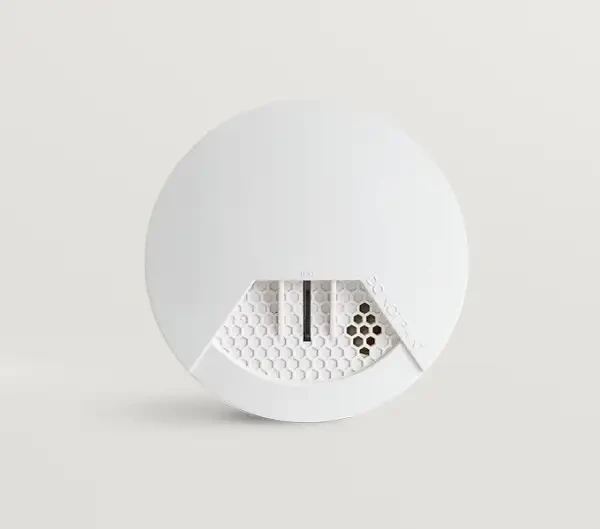Preventing fire damage in the home
Posted January 7th, 2023 by SimpliSafe

In the year ending March 2022, there were 63,482 primary fires - a 3% increase compared to the previous year’s 61,911. Without taking a proactive approach to fire safety in the home, you risk the safety of you and others inside. Not to mention, the cost of fire restoration - from replacing lost valuables to arranging structural repairs - can be substantial. In extreme cases, you could be looking at prices of up to £70,000.
By taking precautionary measures - which you’ll find in this guide - you’ll lessen the chances of falling victim to fire damage.
1) Prevent an electrical fire
In order to prevent the risk of fire damage in your home, be wary of electrical fires. Ensuring that there aren’t too many appliances plugged into an electrical outlet, replacing old or faulty cords, and by routinely checking home appliances such as ovens, dryers and stoves, you can help keep you, your family, and your belongings safe. You could also plug devices into a surge protector, which protects your electronics from voltage spikes and lessens the chance of a fire caused by overheating.
2) Install a smoke detector
Installing a smoke detector is a surefire way to reduce the risk of significant damage caused by a house fire. In the unfortunate event that a fire does break out, the SimpliSafe Smoke Detector, built with photoelectric sensors, will respond to a fire during the early, smouldering stage. By acting quickly, there’s less chance of a fire developing.
For extra security, partner the smoke detector with our 24/7 Pro Premium professional monitoring plan, where our monitoring centre will be notified immediately if the device is triggered. After visually verifying that there is a fire through an Indoor Camera, they will dispatch the emergency services to your home - even if you’re not there.
To ensure that your smoking alarm is in good working order, you could check it once a week, or once a month as a minimum.
3) Be wary of flammable items
Flammable items, such as certain fabrics and paper, should be kept away from open flames to prevent fire damage. For example, when you’re lighting a fire in your fireplace, or a candle, make sure to keep your hair and clothes out of the way. Keep an eye on heat sources as much as you can, and anything situated near them. If you think they’re at risk of catching fire, store them away safely for future use.
4) Avoid smoking inside
According to the London Fire Brigade, smoking is the top cause of fatal fires. Although smoking is never advised, if you do, there are ways for you to smoke safely. It’s advised that you never smoke in bed, or anywhere where you might fall asleep such as sofas or arm chairs, that you use proper ash trays that won't easily tip over, to never balance cigarettes or cigars on an ashtray, and to avoid smoking inside.
5) Use your fireplace safely
For those who have a fireplace, it’s important to use it safely. Make sure that you completely smother the fire once you’re done with it, watching it for a while before leaving the room to make sure that the flames don’t start up again.
6) Reduce clutter
A cluttered home can increase the chance of fire damage, so it’s important to pick up any objects that are lying around. Certain flammable items may cause a fire to spread faster, and dodging these could make your escape slower.
7) Switch off heated appliances when leaving the home
When leaving the house - even if just for a short while - or when going to bed, always make sure to switch off any heated appliances. If left unattended, these could easily catch fire. As you won’t be there to detect the fire, the damage could be substantial.
8) Keep debris to a minimum
Protecting your home from fire damage doesn’t stop on the inside - it’s important to pay attention to the outside of the property, too. A buildup of firewood, leaves, or other flammable materials could catch fire if you’re not careful, so regular maintenance is vital.
9) Change filters regularly
Lint is extremely flammable, so don’t let it build up in your filters. Check your heating system and dryer regularly, as even a small amount of lint could cause a fire to develop.
10) Furnace maintenance
Be sure to schedule regular furnace maintenance, where a professional can check it for you to make sure it’s working as it should. A damaged furnace is a massive safety risk, and problems such as bad wiring, excessive voltage or a restricted airflow could cause the system to overheat and result in a fire.
11) Prepare a safety plan
The key to optimising your home’s fire safety and security is to take a proactive approach, planning ahead wherever you can. Prepare a safety plan which can be used in the event of a fire to ensure that you and your family can evacuate safely and quickly, deciding on a meeting point outside the property. Time is of the essence in this scenario, so don’t risk anyone lagging behind. Here at SimpliSafe, your safety is our top priority. From preventing fire damage in the home to deterring burglars, our home security system can be customised based on your needs. Contact us today to start building yours.